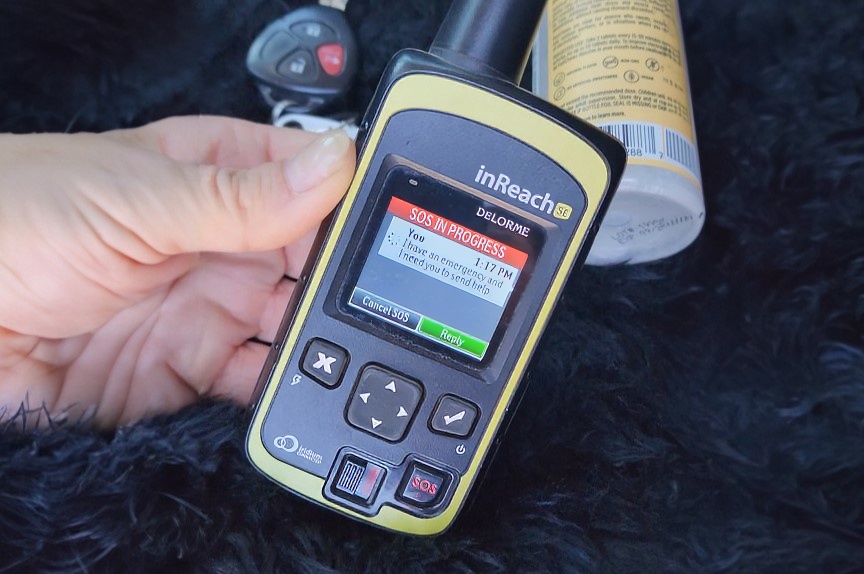
Over the past 10 years of owning the Garmin inReach (formally the DeLorme inReach), I always considered it my lifeline during my adventures in an emergency. I often wondered what would happen if I pressed the SOS button.
Last weekend, I found out. But, the call wasn’t for me, and I wasn’t even out in the backcountry. While at a remote rest stop with no cell service, I encountered a man in severe distress from heat exhaustion, possibly heat stroke. With no other way to get help and no cell service, I pressed the SOS button on my inReach. What followed was a series of eye-opening experiences and lessons about the realities of emergencies in remote areas.
Here are some crucial things I learned when I pressed that button.
Table Of Contents
What inReach Does

These satellite communicators are designed for those who venture into areas without cell service. Hikers, off-roaders, and climbers can all benefit from this invaluable tool. In emergencies, users can contact help via satellites orbiting above the Earth.
When an SOS signal is sent from the inReach, it is transmitted to the Garmin International Emergency Response Coordination Center (IERCC). Staffed 24/7, the IERCC coordinates with the best emergency responders for your situation, ensuring help reaches you as quickly as possible.
1. Preparedness Pays Off

Through all my training and preparation over the years, I’ve learned valuable information for basic first aid. The salt tablets I had were a great help in aiding the treatment of the man with heat exhaustion.
Remember that all items in your emergency stash need to be used, refreshed, practiced with, and understood. There’s no point in carrying band-aids if they won’t stick or alcohol pads and ointment if they’re dried out. Refresh your consumable supplies at least every six months. Heat exhaustion and heat stroke are common emergencies, so carrying salt tablets is a must.
2. Not An Alternative To 911

This experience taught me that inReach is more advantageous for signaling search and rescue responses in hard-to-reach locations. Or, needing helicopter extraction rather than 911 when there is no cell reception.
However, calling for an ambulance in a city isn’t the use case for inReach. In the city, an ambulance can reach the hospital faster than you can drive, so call 911 if you’re in urban areas.
Can Be Useful for Roadside Assistance or Reporting Situations
The IERCC can also be used for advice and coordinating support. Garmin states that 12% of their SOS calls come from individuals needing roadside assistance while out of cell service. You can also report vehicular accidents or other situations that need support. Keep in mind that the arrival of support can take a long time.
3. There Are No Charges For Triggering SOS
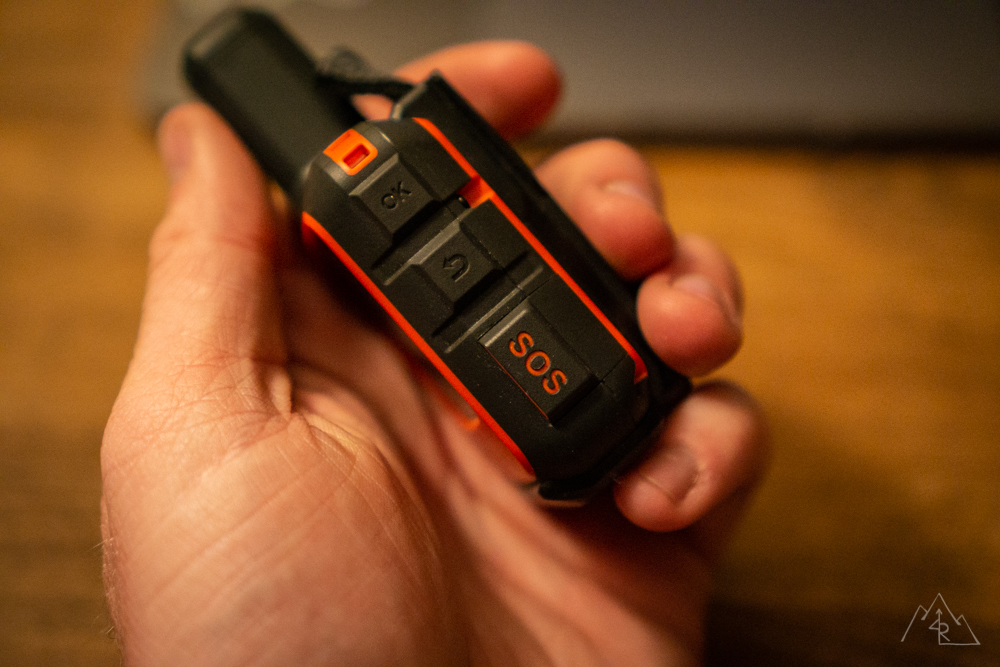
You can trigger an SOS for those around you without incurring personal charges for communicating with Garmin. You are only responsible for costs associated with your own rescue. Any fees incurred for aiding or rescuing someone else are charged to the individual for whom the SOS was triggered.
Garmin does not charge for communication via the SOS button. However, charges from emergency services (sheriff, police, SAR, ambulance, hospital, doctors, etc.) that Garmin coordinates with during an emergency may apply. Any medical expenses incurred typically fall under the jurisdiction of your medical insurance.
Never Hesitate to Hit the SOS Button Due to Money Concerns
In emergencies, time is of the essence and it’s better to be safe than sorry. Delaying could worsen the situation and necessitate a different type of rescue.
4. Response Time
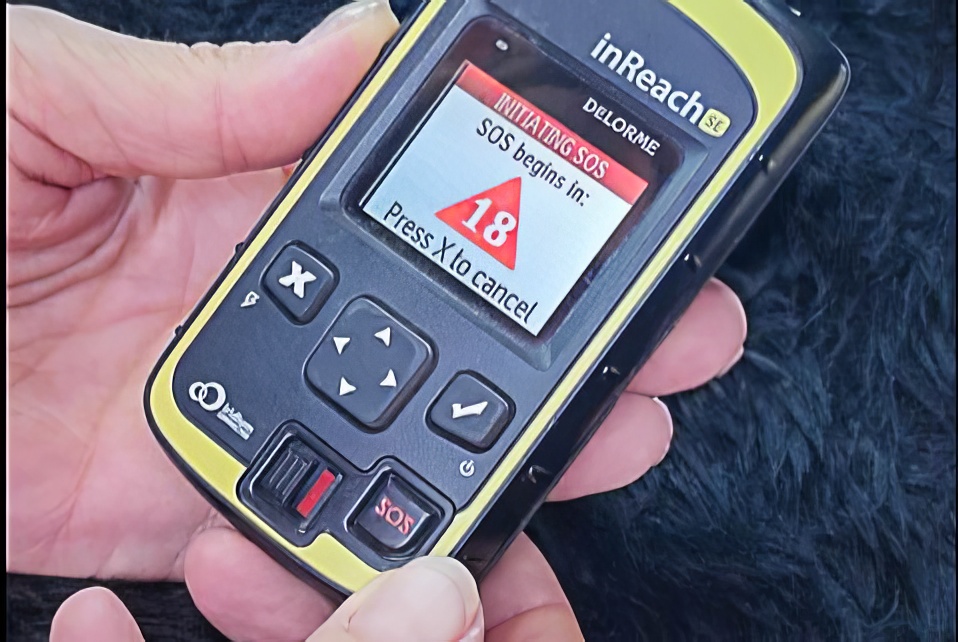
After hitting the SOS button, inReach does a 20-second countdown before sending the first SOS in case it was pressed accidentally.
If you are in a situation where you need to press the SOS button for help, you are likely in a remote area where it will take a considerable amount of time to reach you. Even if you are seemingly close to infrastructure, such as a road, emergency services will still need time to travel from the nearest town that has those services.
My SOS timeline:
- 3 minutes to be acknowledged by the IERCC call center,
- +11 minutes to coordinate and request help from local agencies,
- +11 minutes to confirm that EMS were on their way
- +37 minutes EMS arrival time
In total, it took 62 minutes from SOS kick-off to the time EMS arrived on the scene.
If I had known it would take so long for help to arrive, I might have taken the man to the hospital myself. Being next to the highway, I thought the ambulance would arrive quicker than I could drive. Knowing what I know now, my decisions will be different in the future.
Long Delays Between Texts with the IERCC Call Center
Communication with the call center involved significant delays, with an average of ten minutes between texts. Our exchanges often arrived out of order, making it unclear whether my previous messages had been received. To ensure clarity, I repeated my texts so that my answers followed their questions.
Despite the delays, using inReach to communicate with the call center felt surprisingly familiar, like texting a friend—albeit a friend who took about ten minutes to respond. I had expected the text exchange to be quick, very formal, and canned, but it felt more like a conversation with a real person. This human touch significantly eased my anxiety during the communication.
5. Emergency Contacts
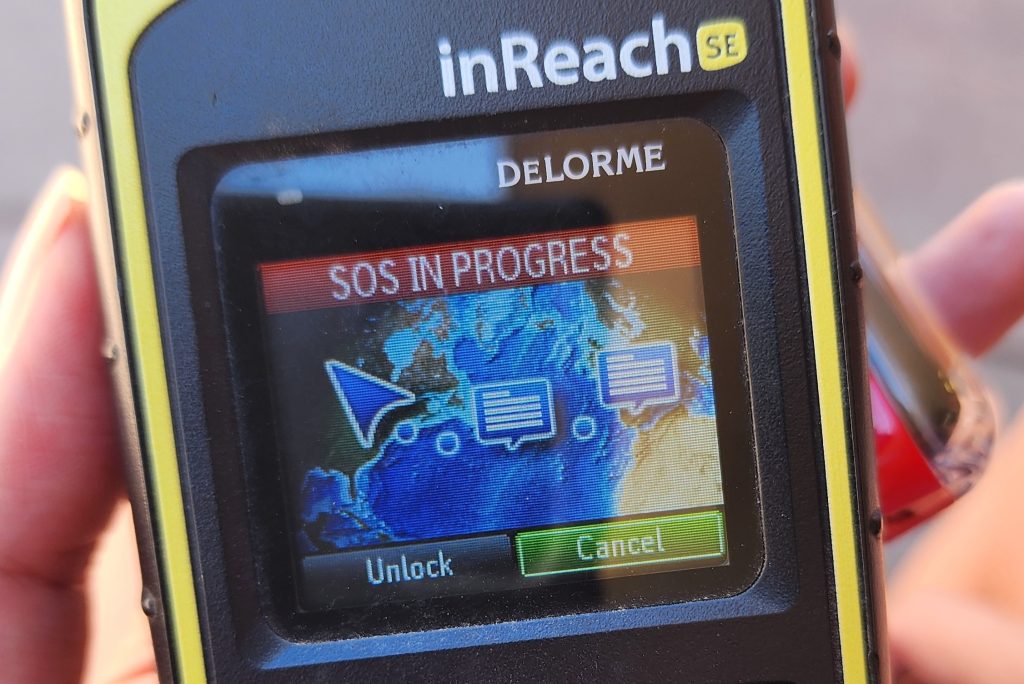
Before activating the SOS button, if possible, inform your emergency contacts via the inReach. I wasn’t entirely sure if the IERCC call center would contact my parents (my primary emergency contact) due to the nature of the emergency.
I decided to text my parents beforehand so there wouldn’t be panic or confusion in case they did call them, informing them that I was hitting the SOS button because I had found a man in distress, that I was ok, and not to worry about me.
Twelve minutes after I activated the SOS, the IERCC did call my parents. They informed them that I had pressed the SOS button and asked for information about me, including my possible location, activities, and a description of me and my truck.
My parents relayed the information I had already texted them, confirming that I was okay and needed help from someone else. The IERCC representative had not yet received this information. Despite my preemptive text, the call still made my parents a bit nervous because of all the questions the IERCC was asking, but they deeply appreciated the heads-up before they called them.
Inform BOTH of Your Emergency Contacts Before Pressing the SOS Button
While I did text my parents, I mindlessly forgot to inform my second contact, a dear friend who is well-equipped to support me if I get stuck. He is an avid outdoorsman, understands the backcountry, has resources to aid in rescue, and can rally additional support if needed. With only two emergency contacts allowed, having him is like accessing a network of 100 people who can help.
As you can imagine, when he got the call, my friend immediately began formulating a response plan. Nevertheless, he texted me, asking if he needed to put out a call on Facebook to recruit someone to assist the man in distress.
Carefully Consider Your Emergency Contacts
After reconnecting with my parents, it prompted me to reconsider my emergency contact strategy. Should my parents always be the first to know in an emergency? A local contact familiar with these situations and who can provide immediate assistance might be better suited.
When selecting emergency contacts, prioritize the ability of your contacts to provide valuable support in an emergency. Close friends often have more current information about me and offer more effective support than my parents, who may feel overwhelmed and unsure of what to do with emergency information.
Consider implementing a call matrix. For example, a trusted friend can receive initial emergency calls and notify others in the call matrix, including my parents, with updated, useful, and actionable information. It’s certainly a conversation worth having with your loved ones.
6. Internal Comms (IERCC) May Be Slow
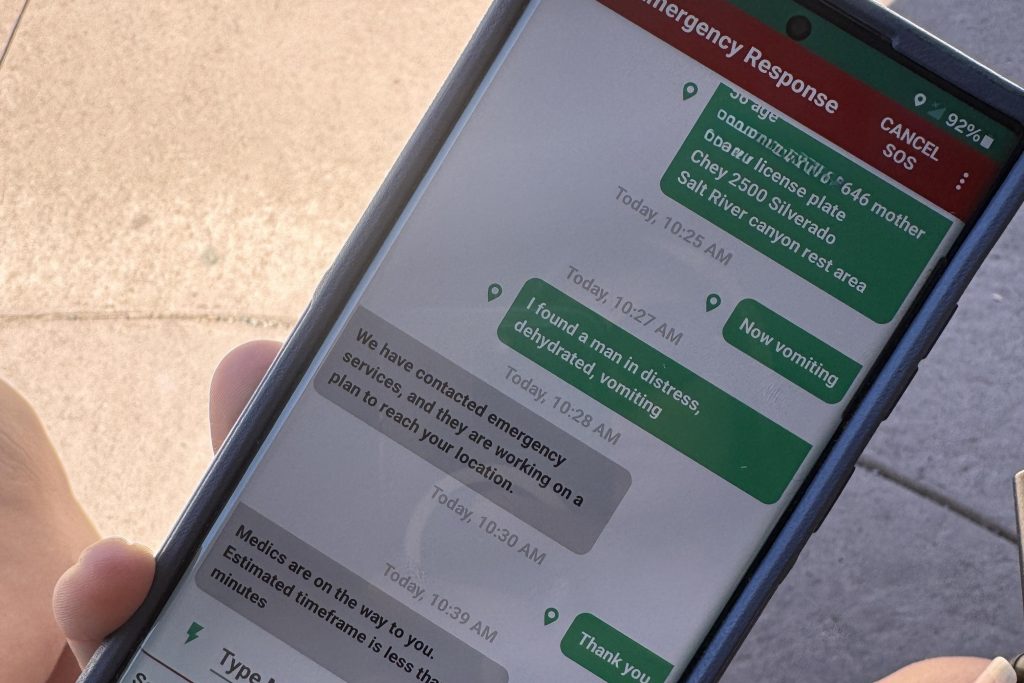
Internal communication within the IERCC might not be very swift. Based on the discrepancies in the information provided to my two emergency contacts, there appear to be two separate internal entities; one managing inbound SOS signals and another handling outbound notifications to emergency contacts.
My parents were notified 12 minutes after I activated the SOS. However, that call mainly informed them of the initial response details. In contrast, when my second emergency contact received the call, they were informed of the SOS details but also that it was for someone else’s emergency and that I was okay.
7. Navigating Messages
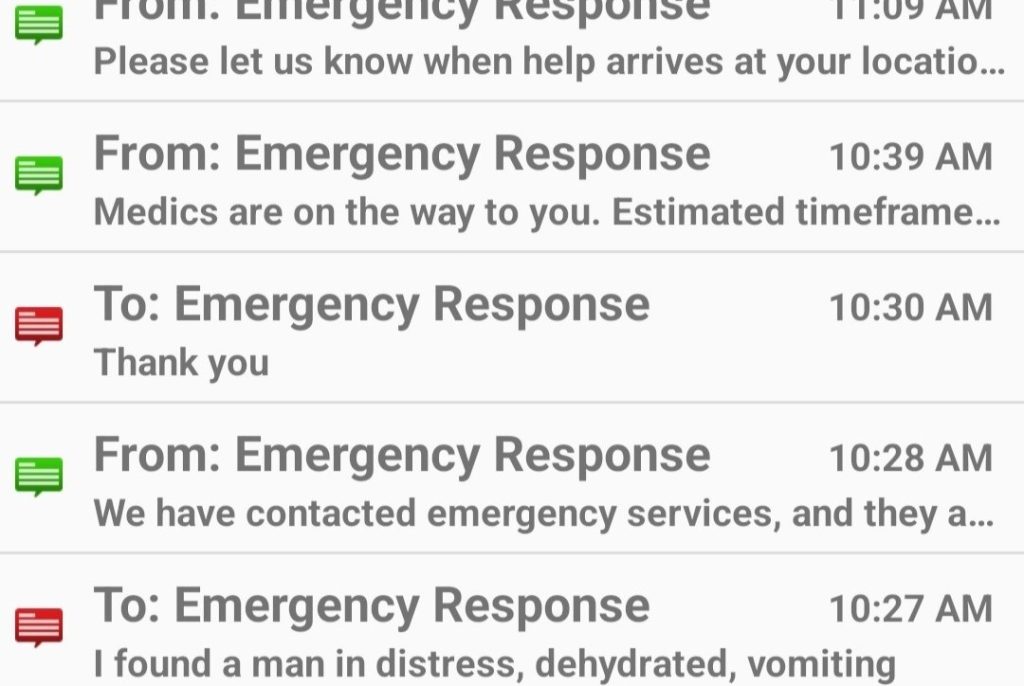
Once the emergency was concluded, I wanted to view the text conversation. However, it was not stored under the general Messages tab. Rather, I found the conversation several days later under the History tab. This was a bit unintuitive.
Final Thoughts

Reflecting on my experience, I realize how crucial it is to be prepared and to understand the tools at your disposal. Even though this was a controlled, low-stress, semi-urban emergency, I learned a lot about how the inReach emergency process works. From the unexpected delays in communication to the importance of strategic emergency contacts, each lesson reinforced the need for understanding the nuances of communications during emergencies.
This also applies to any device that is used during emergencies. Knowing how to use your equipment and having a solid plan can make all the difference. My encounter at that remote rest stop showed me exactly how everything works and I now know how to confidently use it, although I hope to never have to.
Stay safe, stay prepared, and remember, the best tool you have is the knowledge and readiness you bring to the situation.

Thank you Brenda for sharing the lessons learned from your experience.